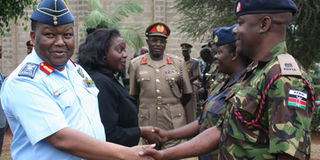Karangi says terrorists’ bodies are with the FBI

Chief of Defence Forces Gen Julius Karangi (left) and Defence Cabinet Secretary Raychelle Omamo (2nd left). The Department of Defence is fighting to save two key military installations from being pulled down and the land, valued at over Sh40 billion, given to two companies. FILE PHOTO |
What you need to know:
- Gen Karangi said there were only four terrorists and they had all been killed during the rescue operation.
- It was the first time security agencies were coming out in the open on the fate of the attackers’ bodies.
Bodies of four people believed to be the Westgate Mall attackers have been handed over to the US.
The Kenya Defence Forces (KDF) chief Julius Karangi said the Federal Bureau of Investigations (FBI) had the bodies but refused to divulge their location.
He was speaking Friday at a public review of the way the September 21 terror attack was handled.
Gen Karangi said there were only four terrorists and they had all been killed during the rescue operation.
“A media house was too happy to report that these fellows escaped that Saturday through a tunnel. Hear it from me; they were killed on Monday morning,” he said.
It was the first time security agencies were coming out in the open on the fate of the attackers’ bodies.
Although Gen Karangi and other government representatives admitted that there was confusion in handling the operation as well as flow of information, he was categorical that no single agency would handle such a matter alone even in future.
“It is always a multi-agency operation and someone has to speak. Some of you have asked me why it took so long. I reply by asking how it long it usually takes,” he said.
The September attack was the worst on Kenyan soil since the August 7, 1998 US embassy bombing.
Seventy people were killed by unknown gunmen at Westgate. Somali al-Shabaab militants claimed responsibility. They said it was in retaliation to KDF’s entry into Somalia.
Gen Karangi spoke “a few things I consider responsible journalism” at the launch of a report by the Media Council of Kenya on how the attack was covered.
The report admitted that some journalists breached their code of ethics by publishing or showing gory pictures.





